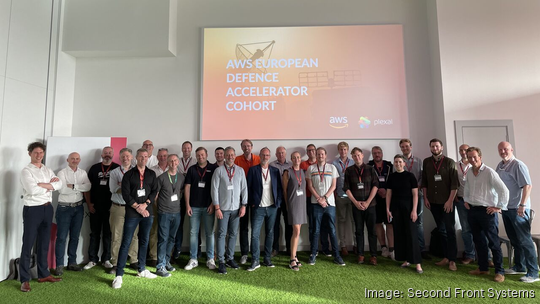
After tripling revenue, opening an office in London and expanding its reach into Australia, a Wilmington-based company specializing in connecting governments with defense software has raised $40 million in one of the largest funding rounds for a tech firm in the Philadelphia area this year.
Second Front Systems plans to use the capital infusion to further fuel expansion in a move that its CEO believes will position the company to lead a "software revolution in defense and national security."
Second Front Systems' Series B round was led by New Enterprise Associates, one of the world's largest venture capital firms, and included follow-on investments from Moore Strategic Ventures and AE industrial Partners' HorizonX. The fundraise comes about a year after the company raised a $32 million Series A in the fourth quarter of 2022 and brings its total funding to more than $80 million.
Beyond the $40 million raise, it's been a big year for Second Front Systems, something the company is looking to build on in 2024, company CEO Tyler Sweatt told PHL Inno. Already this year the company has tripled its revenue from 2022. Sweatt declined to disclose figures but said the company expects to double revenue in 2024.
Part of its growth comes as a result of macroeconomics and the current geopolitical climate, including the ongoing war between Ukraine and Russia and Israel's conflict with Hamas. With unrest happening across the world, defense departments are searching for innovation and ways to make their processes more efficient, putting Second Front's platform in high demand.
"This rising challenge of real geopolitical competition has brought software emerging technology back to the forefront in the national security arena," Sweatt said. "You juxtapose that with public market instability or capital market instability, changing cost of capital, and you've seen a big influx, at least in the near term, of private capital looking to allocate maybe on a new defense thesis."
Founded in 2014 by U.S. Marine Corps veterans Peter Dixon, Mark Butler and Nate Hughes, Second Front Systems' platform allows governments to seamlessly and efficiently integrate commercially proven software applications for their own uses. The platform, known as Game Warden, also allows companies — from startups like Shift5 or Aleria to major tech firms like Ultra Electronics Holdings — to sell their software and have it deployed for national defense purposes. Second Front then provides an operating-system-like experience to integrate the application with government programs and departments.
The platform shortens the integration process with government technology from a matter of years to just days. Sweatt, a military veteran who served in Afghanistan, thinks the software firm has the potential to transform how government entities — specifically in the national security and defense sectors — use commercial software.
"We're kind of sitting in the market between commercial software vendors and the broader sort of global defense and national security community," Sweatt said. "We're really enabling a whole sub-sector of the industry to access this other sort of walled garden market that they really haven't been able to."

Second Front's fundraise comes at a time when many startups are facing headwinds and struggling to raise cash. Sweatt said the firm's rapid growth and ability to connect other software startups with government entities that have money to spend positioned it to pull in "one of the best, if not the best VC in the world" in New Enterprise Associates. New Enterprise lists 412 companies in its portfolio, including Robinhood and Cloudflare, and claims $25 billion in assets under management.
With the revenue growth and new funding, Sweatt is looking to add roughly 40 employees to Second Front's existing headcount of about 100. Those would be in a variety of technical roles in development, security and operations as well as non-technical roles like project managers and account executives. About half of the company's employees come from a national security background, Sweatt said.
In addition to hiring for those roles, Sweatt said the company plans to invest in sales and engineering, along with existing partnerships.
After gaining a foothold in London, where it opened an office this past year, and beginning to work with the Australian Department of Defense as well as NATO, Sweatt is eyeing further international reach.
"As we look out at the next 12, 24, 36 [months] for us to be successful in what we want to do — which is really just fundamentally changing the relationship between commercial software and the global defense/national security community — we've got to be everywhere," Sweatt said.
In the short-term, Second Front could eye expansion in the Indo-Pacific region, specifically South Korea or Japan. Depending on its growth strategy, the company might look to establish offices in countries across the world or have centralized regional offices that serve a handful of nations.
Sweatt also sees the opportunity for growth through mergers and acquisitions, something potential future fundraising might support. It's another tactic the Wilmington startup could employ to scale rapidly around the world.
"For us in five years — and I'll say this having spent the majority of my early 20s running around eastern Afghanistan in the army — if we get this right, this will be the most impactful thing I've ever done for national security. I think the team can universally say that," Sweatt said.







